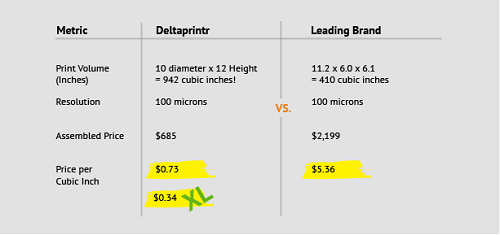If your employer or school lacks the tools you need, the common approach is to voice a complaint and return to your desk with your head down, like a man-child. But Shai Schechter, Andrey Kovalev, Yasick Nemenov, and Eugene Sokolov are not man-children. After realizing that not all universities are equipped with the tools needed to teach 3D sculpting, the four young entrepreneurs decided to build their own affordable 3D printer; this is how the Deltaprintr was born.
The humble device isn’t your typical “affordable 3D printer.” Yes, it’s affordable, but unlike its colleagues, Deltaprintr actually packs the horsepower of a $2,200 Makerbot Replicator 2. Moreover, Deltaprintr costs between $450 and $650 depending on whether you acquire the assembled or unassembled variant.

Deltaprintr’s 100 Micron resolution matches that of the Replicator 2
This cost saving is directly attributed to Deltaprintr’s clever design, not substituting lower quality parts. The printer’s design is based on the Delta robots used in the packaging industry, to provide accurate, high speed printing with fewer moving components than traditional 3D printers. This translates to a direct cost cutting to the customer.

Customary to delta robots, Deltaprintr's 3 arms are connected to universal joints at the base
In an interview with Electronic Products, Shai points out that increaing the printing speed of a traditional Cartresian printer involves keeping many more parts in sync makes it difficult to maintain accuracy. “When you ramp up the speed on a Cartesian printer, it has to keep all these parts in sync at all times to keep the resolution high, and that is where the challenge is. On a Deltaprintr, you only have one moving part, essentially, the hot end. This allows the printer to move much faster and keep the resolution high.”
Print volume
A minimal carriage design lets you slide the assembled carriage onto the extruded aluminum beams without requiring any adjustments. If the default volume of 942 cubic inches doesn’t suite your fancy, swapping the beams with longer one is all it takes to expand the print volume. The 10 inch diameter build platform may also be widened by replacing the top and bottom wooden pieces. An expansion pack will be provided in the near future for those who wish to upgrade their Deltaprintr.
The huge print volume results from the inclusion of a 65lb Spectra fishing line that’s responsible for moving the arms. Shai told EP that this is one of his favorite features, “When people see the printer from a short distance away, they don’t understand what is moving the arms until we point out the fishing line and then you watch their eyes dilate! It’s a great feeling seeing someone inspired”
Material type and nozzle size
Deltaprintr uses 1.75mm PLA filament extruded through a 0.4mm nozzle attached to a J-Head hot end. Printing speeds can reach 200mm per second, but vary depending on material and selected settings. Deltaprintr’s material upkeep cost is a significant highlight of the product, costing $0.74 price per cubic inch for the default size, or $0.34 price per cubic inch with the expanded rods. This is signficantly cheaper than the Makerbot Replicator 2’s $5.36 price per cubic inch and makes for a very school friendly product. You won’t cringe after ever printing job.

Other unique features
Recalibrating the printing bed level is part of the regular maintenance of 3D printers, but not the Deltaprintr. Deltaprintr uses a probe attached next to the hot end to automatically recalibrate the printer for you, by poking the bed in a grid pattern and adjusting for any errors in levelness. This way, the printer ensures exact prints every time. Additionally, each Deltaprintr unit comes with a custom-built LCD attachment. No need to upgrade.
Q&A with Shai Schechter
1. How did you achieve such a low level of price per cubic inch? (It’s very impressive!)
The low price was achieved because most of our components are off the shelf. Where we saw there was room for improvement, we decided to custom design it. Most of our components are shipping from overseas, so finding the right resources was important as well.
2. What sparked your decision to use a 0.4mm nozzle over a 0.35mm persay?
We went with a 0.4mm nozzle instead of a 0.35mm because 0.4mm allows you to push the plastic faster and therefore let you print faster. A 0.35mm nozzle would require higher temperature to push the plastic at the same speed. Many users believe that the smaller the nozzle, the better the resolution. That is not exactly true. If your machine is tuned very well, then you can use any nozzle and you won’t notice any defects regardless of the nozzle size.
3. What were your primary design challenges when balancing cost and performance?
One hard decision we had to make was the LCD screen. Those things are expensive and are why many people offer it as an upgrade option when they sell 3d printers. So we took the extra step here and decided to design our own electronics that has the LCD integrated into it – no more upgrades! This allows us to lower the cost of manufacturing. We believe everyone should have a great experience using their printer and having an LCD is part of it.
4. What was the most complicated component ever fabricated with the Deltaprintr?
I would like to say that the most complicated component would probably be the hot end. It’s a very delicate process and in some way is a work of art to figure out a good design for the hot end. Therefore, we decided to use the already proven J-Head hot end Design.
5. Deltaprintr is immensely affordable compared to other delta robot base 3D printers, how did you manage to cut so much of the cost? Was it through the removal of the heating bed?
Yes the Removal of the heated bed did help significantly. We would otherwise need a larger power supply, which also makes shipping more expensive.
Visit Deltaprintr’s Kickstarter page to procure your own printer
Advertisement
Learn more about Electronic Products Magazine





